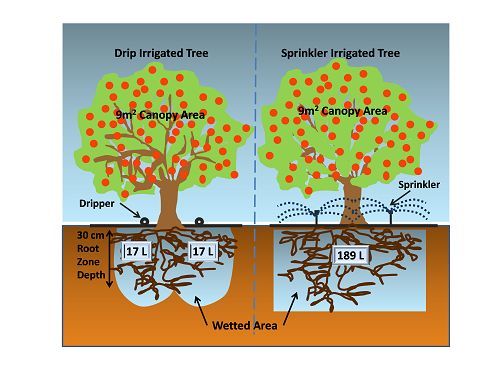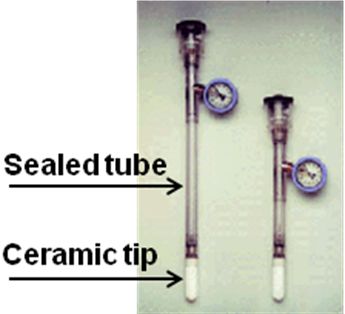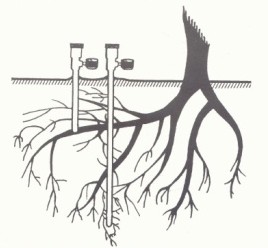Index:
1.1 Growing conditions
Being a tropical and subtropical crop, citrus can be grown in a belt between 40 °N and 40 °S, except at high elevations. Minimum temperature and its duration time are the limiting growth factors sensitivity depends on variety, rootstock, dormancy of the trees and the absolute minimum temperature and its duration.
Intensive citrus cultivation requires the use of fertilizers, close monitoring and control of pests, diseases and weeds, effective irrigation and control of tree size. The trees begin their productive life on the third year, and peak productivity takes place when the trees are 10-30 years old, average yields under these conditions are 30-60 t/ha.
Extensive citrus cultivation requires with the use of fertilizers, but only moderate monitoring and control of pests, diseases and weeds. They are generally rain-fed only. Their productive life starts on the fourth year, and peak productivity takes place when the trees are 8-15 years old, average yields under these conditions are 15-25 t/ha.
1.2 Soil type
Citrus can be grown on a wide variety of soils, from sand to loam and clay. Both acidic and alkaline soils are acceptable.
1.3 Varieties
The genus Citrus is an evergreen tree belonging to the family Rutaceae. It has about 150 genera and 1500 species, all native to the tropical and subtropical regions of Asia and the Malay Archipelago.
The principal citrus scions are:
- Orange (C. sinensis Osbeck)
- Mandarin (C. reticulata Blanco)
- Lemon (C. limon [L.] Burm.)
- Lime (C. aurantifolia [Christ.] Swing.
- Grapefruit (C. paradisi Macf.)
- Pomelo (C. grandis [L.] Osbeck)
The most commonly used rootstocks are:
- Rangpur lime (C. limonia Osbeck)
- Rough lemon (C. jambhiri Lush.)
- Sour orange (C. aurantium L.)
- Cleopatra mandarin (C.reshni Hort.)
- Trifoliata (P. trifoliata [L.] Raf.)
1.4 Climate
Both arid and humid climates are acceptable. As citrus trees are sensitive to low temperatures, the limiting parameter for growing citrus is the minimum temperature prevailing in winter time.
1.5 Irrigation
Irrigation is one of the most important factors in producing a good yield of quality citrus. Irrigation scheduling, knowing how much water to put on and when, has a direct impact on tree health as well as fruit yield, size and quality. Without correct irrigation scheduling, orchard is more susceptible to nutrient deficiencies, physiological disorders, pests and disease.
Correct irrigation scheduling requires an understanding of:
- How much water can be held in the crop root zone
- How much water the crop uses each day
- How much water the irrigation system applies.
Shallow root system
Citrus have a shallow root system. It is important to aim irrigation at the effective root zone, minimizing the amount of water leaching past. For citrus, the effective root zone is usually in the top 30 to 40 cm, depending on the soil type.
How much water can the root zone hold?
The amount of water that can be held in the root zone and thus available to the tree varies with the irrigation system, soil type, depth of the effective root zone, and proportion of stone or gravel in the soil.
Examples of water holding capacity
Both trees in this example (Fig. 1) are the same size (9 m2 canopy area) growing in a hedge row in a loam soil. The root-zone depth of both trees is 30 cm. One tree is irrigated with two drippers, the other with a fully overlapping micro sprinkler system. The tree irrigated with two drippers has only 34 liters of readily available water. The tree irrigated with the fully overlapping sprinkler system has a much larger volume of readily available water (189 liters). The more soil is wetted within the root zone, the greater the volume of readily available water.
Figure 1: Example of water holding capacity

Scheduling irrigation
To schedule irrigation, the amount of water available in the crop root zone with the tree’s daily water requirement should be compared. If the daily water requirement exceeds the amount of water that can be held in the root zone, there will be a need to irrigate more than once a day. If the soil can hold more than the daily water requirement, there is an option of irrigating when the available water is depleted (this may be every second or third day).
Rainfall during the irrigation season may reduce the irrigation requirement of trees. Not all rainfall is available to the trees; some is lost to run-off, percolation below the root zone, and interception by leaf litter or mulch.
Over-irrigation, especially surface irrigation, may wet the trunks of the trees and increase the incidence of root rot caused by Phytophthora. Lime-induced chlorosis can be aggravated by over-irrigation, and tends to be reduced by drip irrigation. Irrigation timing is considered crucial for reproductive development, fruit set and fruit enlargement. However, cropping in one season influences both root extension and top growth, often with a carry-over effect on yield in the successive year.
Recommendations
The following recommendations are for healthy and productive orchatd. Citrus orchards that above average yield is expected, there is a need to increase the irrigated water quantity by 10% as of the bearing fruit stage (early summer).
Irrigation schedule should start according the soil moisture that can be determined by soil samples with auger or tensiometers (a moisture measurement tool). It directly measures the physical force that the root system must overcome in order to access water held in the soil (also known as matric potential).

Placement of tensiometers in the orchard, according to the irrigation method:
- Drip irrigation – 15-20 cm of the second emitter from the tree’s trunk.
- Micro-sprinkler – 0.5 m from the mini sprinkler.
- Sprinkler – 1 m from the sprinkler.
Depth placement of tensiometers:
Upper – 20-30 cm deep (most of the active root zone) and the reading from this tensiometer with determine the irrigation schedule.
Lower – 50-60 cm deep, verifies the irrigated depth.
Irrigation intervals will be determent by the age of the citrus orchard or tree size, irrigation method, soil type and the daily water requirement (Table 1).

Table 1: Irrigating intervals (days):
| Irrigation method | Drip | Mini sprinkler | Sprinkler | ||
| Orchard age | Young | Mature | Young | Mature | Mature |
| Soil type | |||||
| Light | 1 | 1 | 2 | 1-4 | 7 |
| Medium | 2 | 3-4 | 3 | 2-5 | 10 |
| Heavy | 3 | 1-5 | 3 | 5-7 | 14 |
Irrigation of young orchard (up to 4 years from planting):
The water quantities are per single tree and related to irrigation method to the tree size.
Table 2: Drip irrigated young citrus orchard (up to 4 years from planting)
| L/tree/day | Emitters /tree | |||||||
| Spring | Late spring | Early summer | Summer | Late summer | Early fall | Fall | ||
| 1st year | 1 | 2 | 3 | 4 | 5 | 5 | 5 | 1 |
| 2nd year | 10 | 10 | 10 | 12 | 15 | 15 | 15 | 3 |
| 3rd year | 15 | 20 | 22 | 25 | 25 | 25 | 20 | All emitters open |
| 4th year | 20 | 25 | 30 | 40 | 40 | 40 | 30 | |
Irrigation of bearing trees
Due to the variation in water consumption between different growing areas, varieties, expected yield, soil type, drainage problems and so on, it is impossible to provide irrigation schedule that will fit all citrus orchards.
It is important to use additional parameters to determine irrigation schedule:
- Soil sampling auger
- Tensiometers
- Measuring fruit size.
How to calculate the water requirement
The daily required amount of water is calculated by multiplying the seasonal irrigation factor, varies from area to area and differs according to varieties, by transpiration factor generated from a Class 'A' Pan Evaporation data. To determine the required water quantity, the daily quantity should be multiplied by number of days from the last irrigation (irrigation cycle).
Irrigation factor - is the correlation between the transpiration from the tree and the evaporation from Class 'A' Pan (Evapotranspiration) of a citrus orchard during a particular period.
Group A: Varieties no fear of too large fruit size and plots with above average yield.
Group B: Varieties with low yield and fear of oversized fruits.
Group C: Late grapefruit varieties – yield less than 60 ton/ha, Topaz variety yields less than 40 ton/ha.
Group D: As of late spring, irrigation according to fruit size.
Table 3: Irrigation factors according to different citrus groups
| Group | Spring | Late spring | Early summer | Summer | Late summer | Early fall | Fall | Late fall |
| A | 0.30 | 0.38 | 0.45 | 0.52 | 0.59 | 0.65 | 0.71 | 0.77 |
| B | 0.30 | 0.37 | 0.43 | 0.48 | 0.53 | 0.57 | 0.60 | 0.63 |
| C | 0.30 | 0.35 | 0.38 | 0.40 | 0.40 | 0.38 | 0.35 | 0.30 |
| D | 0.45 | 0.53 | 0.63 | Irrigation according to fruit size | ||||
Example of calculation:
0.55 (irrigation factor) X 7 mm (daily evaporation data from Class 'A' Pan) X 4 days irrigation interval = 15.4 mm, or X 10 = 154 m3 water/ha.
1.6 Planting density and expected yield
Tree spacing is affected by factors such as the species of citrus concerned, the cultivar, type of rootstock, environment, size of the orchard and the management practices the grower will be using. For example, if a grower uses machinery, he must leave enough space between the rows for the machines to pass when the trees are mature. Site quality in terms of soil characteristics and water availability should be considered. Expected lifetime of the orchard is also important and may be influenced by freeze potential, disease incidence, or non-agricultural development potential. Thus, decisions must be based on a number of situations.
Spacing of 6 - 7.5 m between rows and a middle width of 2 to 2.5 m provides adequate access for production and harvesting operations. Within this range, more vigorous trees, such as: grapefruit, lemons, tangelos, and other varieties with more spreading growth habits should be planted at wider spacings than oranges.
Spacing wider than 7.5 m take longer to fill their allocated space, thus reducing early yield potential.
Spacings between rows as close as 4.5 m can be managed with conventional production equipment with timely row middle hedging, however, fruit handling at these closer row spacings becomes a problem.
Spacing in the row of 3 to 4.5 m is considered suitable for new plantings. Tree vigor, site selection and external fruit quality requirements again are important considerations within this range. With the rapid tree growth occurring in many new plantings, trees at this spacing will grow together to form a continuous hedgerow relatively early in the life of the planting.
Spacings less than 3 m in the row have been tried experimentally and in a few commercial plantings. However, trees planted too closely may compete with each other for space at such an early age (before significant production) that the advantage of the higher density does not justify the additional cost of trees. Spacing trees at regular intervals in the row is preferable to grouping trees. For example, regular 3 m spacing is more desirable than grouping two trees 1.5 m apart and then skipping 4.5 m, even though the tree density per an area is the same.
Tree densities range from 286 trees per hectare for the 4.5 X 6.5 m spacing, to 540 trees per hectare for the 3 x 6 m arrangement. Small acreages of densities of up to 865 trees per hectare might be considered on a trial basis.
Tree vigor is of fundamental importance in determining the tree spacing, density, topping, and hedging in new citrus orchards. Citrus tree are flexible and adapt to arrangement of space allocations. Adaptability is limited, however, and maximum economic returns are generated only when tees perform well within their allocated space.
Need more information about growing citrus? You can always return to the citrus tree fertilizer & citrus crop guide table of contents
Related Articles:
NPK Fertilizers - Water Soluble Fertilizers
Informations about Plant Nutrient deficiency






